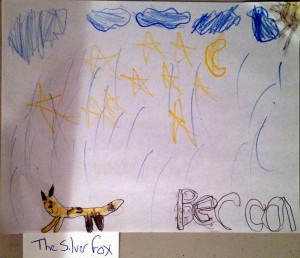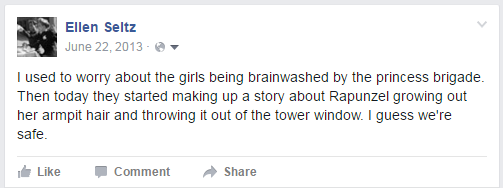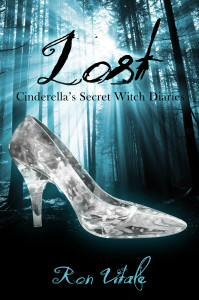I’ve been participating this week in Jeff Goins’ Intentional Blogging Challenge (albeit at my own pace). One wonderful benefit has been getting to know and share with other authors. My guest today is speculative fiction author Ron Vitale, the author of the New-Adult series Cinderella’s Secret Witch Diaries. I’ll be cross-posting to Ron’s site today as well, at www.ronvitale.com.
We both have concerns about raising daughters bombarded by the princess-industrial complex. My family is dealing with it our way:
Ron’s got his own approach. Over to you, Ron:
Make Your Own Fairy Tales
When my daughter turned two, I had had enough. Enough of the princesses, Barbies and pink toys. If you haven’t been to a Toys ‘R Us in some time, walk through the store and you’ll come across the row of pink toys. I just couldn’t swallow it any longer, and decided that if I wanted to change things, then I needed to write my own series.
I read to my daughter every night that I put her to bed and had enough of the Disney stories in which the princess was rescued by the prince. I wanted to change that so I decided to write a darker and bolder series that answered the question: “What really happened to Cinderella after she married the prince?”
My Cinderella’s Secret Witch Diaries series is not meant for young kids. The books are for an older audience and I decided to explore Cinderella’s inner turmoil and make it a much messier adventure. Yes, that means my daughter will have to wait a bit until she can read them, but I didn’t want to write a series that was so formulaic. I wanted Cinderella to be flawed. She has a difficult time finding her way, but, at the end of it all, she realizes that she doesn’t need a prince (or any man) to save her. She needs to save herself. She’s a self-rescuing princess.
The more recent genesis of my idea for the series came after my daughter was born, and I started paying more attention to the nonsense she would have to deal with as she grew up: Bic released the “Pen for Her,” how women were often sexually objectified in film as well as in life, and the ongoing discussion about the lack of equal pay for women in the same job as men.
But the actual seeds of my ideas of writing about strong women protagonists goes back nearly 20 years before I ever wrote my first line of the Cinderella series. I grew up in a divorced family, and my mom raised me as best she could working full-time. She needed to move back home with her parents because she could not afford to be on her own.
I took all that I learned from my upbringing, the good and the bad, and learned that through education I could rise up and become a better person. My mother and grandmother instilled in me the importance of hard work both out of the house and within. I believe that there should not be any distinction between what a man or woman does on the home front. It’s a foreign concept for me to not want to participate and be all-in when it comes to running a household and raising children.
When I grew up and went to college, the first in my family to do so, it’s no surprise that I became drawn toward literature and psychology. I wanted to learn more about people, their stories and motivations and how we can learn from each other. My Master’s thesis is a Jungian interpretation of the works of Margaret Atwood and Alice Walker. I explored how the female protagonists in their novels used the art of storytelling to overcome the abuse they suffered in their lives. And if I could boil down my novels to their most quintessential element, I am doing the same.
I have taken the most basic archetypal aspects of the hero and flipped them around so that the hero’s journey (as discussed by Joseph Campbell) becomes a woman’s journey and not the typical male hero. Cinderella in my series has been abandoned by family, neglected by her husband and is unaware of her own power. She’s looked to others all her life to help and save her, but I wanted that to change. Though her road is twisted, and sometimes borders on selfish, she struggles to find a path toward the light in a Napoleonic Europe.
When I wrote the series, I did so for when my daughter is older and hoped that my version of Cinderella could be a role model for other young women as well. Just as J. K. Rowling wrote from a male perspective, showing Harry Potter’s rise to fame and overcoming his family tragedy so I chose Cinderella and have written books to show her rise to power.
Without giving anything away, I remember the moment when I discovered the essence of the first book. I had written the first draft, and during a rewrite, a bolt of inspiration hit me when I least expected it—I was driving toward the train station headed to my day job. I quickly parked the car, jotted my ideas down on scraps of paper and realized that I had charted out the path for not only my heroine but the world around her and the story’s antagonist. I had found my bad guy.
I look back at my life experiences, the college courses I took and books I’ve read along the way and see a fabric of influences and inspirations that stretch out, like a comforting quilt that was more than 25 years in the making. I don’t think I could have written the book or come up with such an interesting antagonist without that experience. And what I originally set out to do, write a book for my daughter, grew into a series to focus on female empowerment that I could leave as a legacy for not only my own children but for other teenagers as well.
If my books can be the first in a line of many other authors’ ideas to challenge the status quo of women’s role in society, then I’m honored to be part of that discussion. In a way, my words are a proxy for the suffering I saw my own mother go through over the years as she struggled to raise my brother and I on her own while working full-time. And for me, the point of my series is that I believe one book can change the hard brick wall of our world.

In the 21st century, it’s even more important than ever to question and strive, invent, create and embrace learning in all its wonders. My daughter doesn’t need a pink Lego princess castle, but a pile of loose bricks so that she can create whatever she can imagine. The imagination is limitless and I strive to share that message with my children,
not by telling them, but by showing them.
When I wrote Found, the third book in the series, I met separately with my kids and asked if they wished to help me. When they said yes, I gave them crayons, markers, paper and index cards with the main characters’ names and a brief description on the cards. I then asked them to draw whatever they thought the characters looked like. I took the completed drawings and hung them up on my bedroom wall along with plotting notes. Not only did the drawings help me to see my characters in a timeline, but I was able to show both my kids that they can create now (and my daughter didn’t need a “for her” pen to do so!) No one need tell them how to be creative or when they can do so. They can just be.
And that’s the core message of my Cinderella books. It took years for Cinderella to find herself, but she grows up to blossom in her own power and strength—without needing a man’s help.
Ron Vitale was born and raised in Philadelphia, Pennsylvania. Influenced by the likes of Tolkien and Margaret Atwood, he began writing at an early age, creating short fiction from his Dungeons & Dragons role-playing sessions.
His writing has appeared in various places from elephant journal, SFWA’s The Bulletin and SEARCH magazine. When not writing articles, he also is the author of the Cinderella’s Secret Witch Diaries series geared toward new adults. Currently, he is keeping himself busy by writing his blog, and on learning how to be a good father to his kids all while working on his next novel. Read more at www.ronvitale.com/blog


